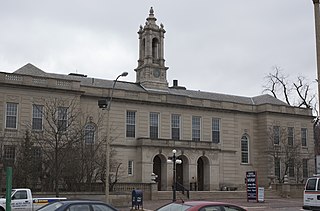
Arlington is a town in Middlesex County, Massachusetts, United States. The town is six miles (10 km) northwest of Boston, and its population was 46,308 at the 2020 census.
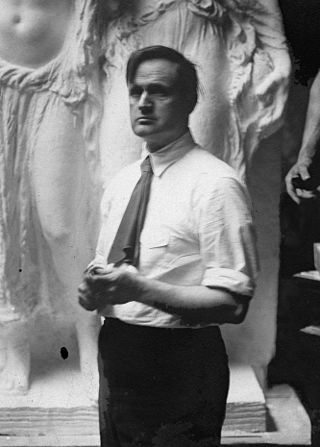
James Earle Fraser was an American sculptor during the first half of the 20th century. His work is integral to many of Washington, D.C.'s most iconic structures.

Cyrus Edwin Dallin was an American sculptor best known for his depictions of Native Americans. He created more than 260 works, including the Equestrian Statue of Paul Revere in Boston; the Angel Moroni atop Salt Lake Temple in Salt Lake City; and Appeal to the Great Spirit (1908), at the Museum of Fine Arts, Boston. He was also an accomplished painter and an Olympic archer.
Arlington High School is a public high school located in Arlington, Massachusetts. As of 2022, the school enrolled 1,483 students.

Appeal to the Great Spirit is a 1908 equestrian statue by Cyrus Dallin, located in front of the Museum of Fine Arts, Boston. It portrays a Native American on horseback facing skyward, his arms spread wide in a spiritual request to the Great Spirit. It was the last of Dallin's four prominent sculptures of Indigenous people known as The Epic of the Indian, which also include A Signal of Peace (1890), The Medicine Man (1899), and Protest of the Sioux (1904).

Bashka Paeff, was an American sculptor active near Boston, Massachusetts.

The Uncle Sam Memorial Statue is a statue commemorating Samuel Wilson, perhaps the original Uncle Sam, near his birthplace in the center of Arlington, Massachusetts, United States. It was sculpted by Theodore Cotillo Barbarossa. It is located on Mystic Street, across from the Cyrus Dallin Art Museum, and adjacent to the Minuteman Bikeway.

The Arlington Center Historic District includes the civic and commercial heart of Arlington, Massachusetts. It runs along the town's main commercial district, Massachusetts Avenue, from Jason Street to Franklin Street, and includes adjacent 19th- and early 20th-century residential areas roughly bounded by Jason Street, Pleasant Street, and Gray Street. The district was listed on the National Register of Historic Places in 1974.

The Taylor-Dallin House is a historic house in Arlington, Massachusetts. The house is notable as being the home of sculptor Cyrus E. Dallin (1861–1944) from 1899 until his death. It is a Colonial Revival/Shingle style 2+1⁄2-story wood-frame structure, with a hip roof studded with dormers, and a front porch supported by Tuscan columns. The house was built c. 1898 by Jack Taylor and sold to Dallin in 1899. Dallin's studio, no longer extant, stood in the rear of the property. Dallin was one of Arlington's most well-known citizens of the early 20th century, and his sculptures are found in several public settings around the town.
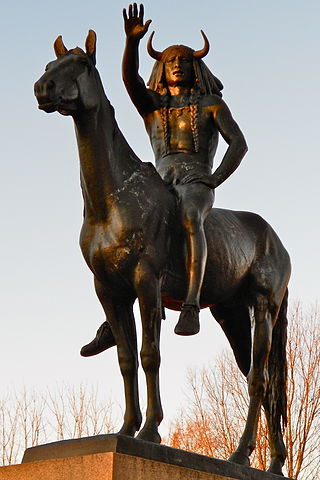
The Medicine Man is an 1899 bronze equestrian statue by Cyrus Edwin Dallin located on Dauphin Street, west of 33rd Street, in Fairmount Park in Philadelphia. The statue portrays an indigenous American medicine man.

A Signal of Peace is an 1890 bronze equestrian sculpture by Cyrus Edwin Dallin located in Lincoln Park, Chicago. Dallin created the work while studying in Paris and based the figure on a member of Buffalo Bill's Wild West Show, which he attended often. He exhibited the original plaster version of the sculpture at the Paris Salon of 1890, where it won honorable mention.

The Cyrus Dallin Art Museum (CDAM) in Arlington, Massachusetts, United States is dedicated to displaying the artworks and documentation of American sculptor, educator, and Indigenous rights activist Cyrus Dallin, who lived and worked in the town for over 40 years. He is well known for his sculptural works around the US including The Scout in Kansas City, Missouri, TheSoldiers' and Sailors' Monumentin Syracuse, New York and The Signal of Peace in Chicago. Locally, he is best known for his iconic Appeal to the Great Spirit and Paul Revere Monument statues, both located in Boston.
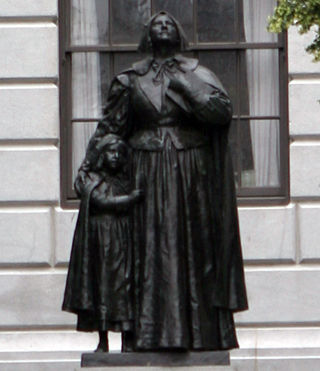
A statue of Anne Hutchinson by Cyrus Edwin Dallin is installed outside the Massachusetts State House, in Boston, Massachusetts, United States.

An equestrian statue of Paul Revere by Cyrus Edwin Dallin is installed at Paul Revere Mall near the Old North Church in Boston, Massachusetts.

Massasoit is a statue by the American sculptor Cyrus Edwin Dallin in Plymouth, Massachusetts. It was completed in 1921 to mark the three hundredth anniversary of the Pilgrims' landing. The sculpture is meant to represent the Pokanoket leader Massasoit welcoming the Pilgrims on the occasion of the first Thanksgiving.

The Robbins Memorial Flagstaff (1913) is a structure supporting and topping a flagpole in Arlington, Massachusetts created by Cyrus Dallin. The supporting sculpture includes a variety of sculptural elements including bronze figures, stone eagles, and snapping turtles with a finial representing American Agriculture. The sculpture resides to the west of Town Hall at 730 Massachusetts Avenue.

Boy and His Dog Sculpture or Storrow Memorial is a 1923 statue by Cyrus Dallin, located in a prominent location in Lincoln Cemetery. It portrays a young man bending down to pick a flower with a dog gazing up into his visage. It was created at the request of Helen Osborne Storrow as a memorial to her husband James Jackson Storrow. The Storrows are interred 30 feet north of the monument across a small road in a grave overlooking a picturesque pond.
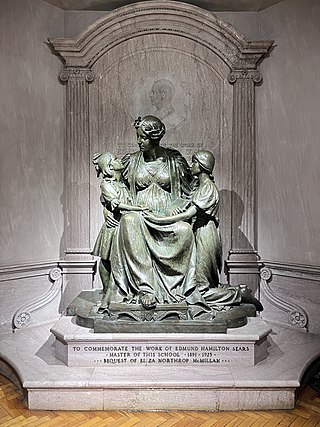
Alma Mater (1916) is a three-figure sculpture by Cyrus E. Dallin in the Mary Institute and St. Louis Country Day School in Ladue, Missouri that was known as one of his more prominent works at the time and is considered to be among his finest achievements by Kent Ahrens. The sculpture is made of cast bronze and sits on a pediment of pink Tennessee marble with a stone backing that has two ionic pilasters supporting an arching molding. The backing panel also has a bas relief profile portrait of the honoree, Professor Edmund Sears, that is partially obstructed by the bronze figures.
















